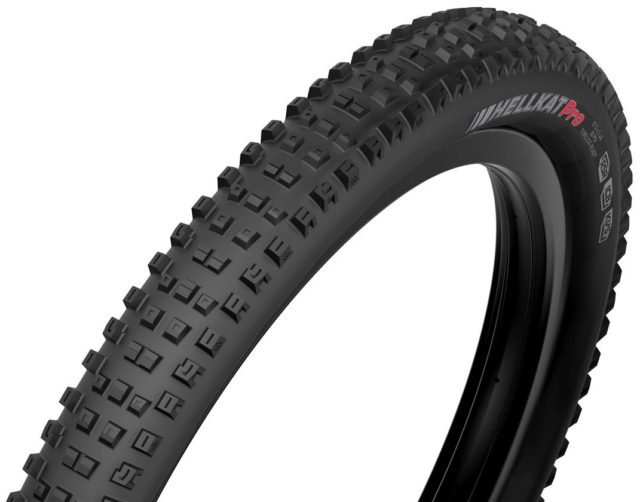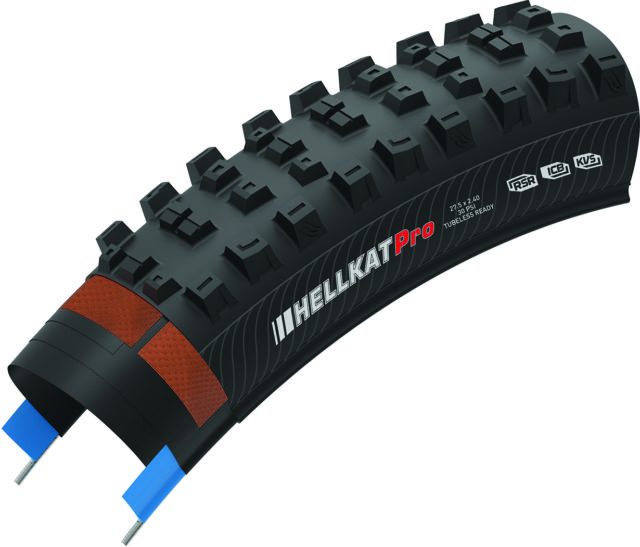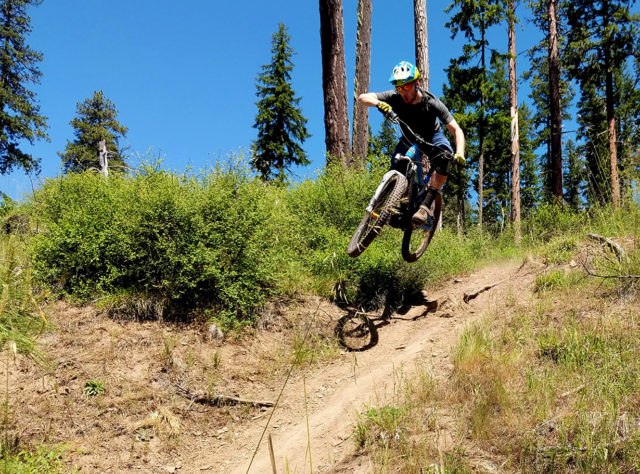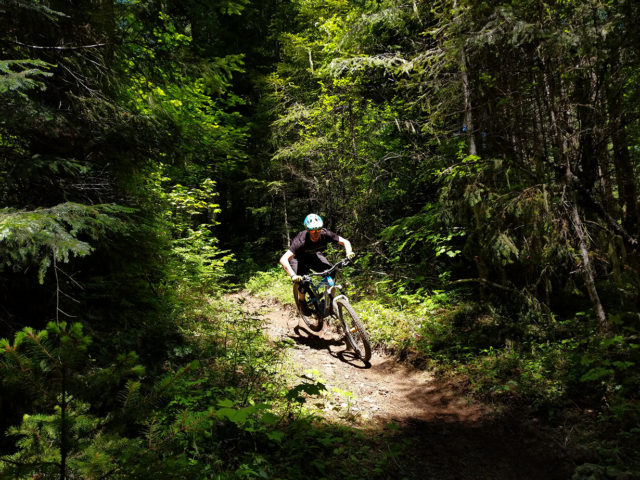
Kenda Hellkat Pro
Stated Size: 27.5” x 2.4”
Measured Width: 58 mm casing width (2.28”) on a 30.5 mm internal rim
Casings: Kenda ATC and AGC
Rubber Compounds:
- ATC version: Kenda EN-DTC
- ATC version: Kenda RSR dual compound
Blister’s Measured Weight:
- ATC version: 797 grams
- AGC version: 1180 grams
Mounted to: Zerode Taniwha / Industry Nine Enduro S wheels
Recommended for: Enduro / DH
Stated Features:
- Advanced Gravity Casing (AGC) – three pieces of KVS help prevent cuts and punctures, and a 20mm apex reduces the chance of pinch flats or burping.
- RSR evolution – New RSR dual layer compound for better control and long tread life.
- Versatile – Tread design is optimized for a wide range of conditions balancing traction, handling and rolling speed.
- Superior flat resistance – The new ATC casing uses Kenda’s proprietary lightweight material K-Armor to increase puncture resistance by 174% over traditional aramid breakers.
- Responsive ride – EN-DTC dual tread rubber balances wear and grip, letting the knobs do the work of control and braking on the ground.
MSRP: $79.95
Rider: 5’10”, 143 lbs.
Test Locations: Mammoth, Bishop, & Santa Cruz, CA; Oakridge & Ashland, OR
Test Duration: ~4 months
Intro
Last year, Kenda introduced the Hellkat Pro, an all-conditions tread aimed squarely at the gravity crowd.
Getting a share of this segment is always going to be a challenge, as new tires have to go head to head against the genre’s longstanding stalwarts, namely the Maxxis Minion DHF and Schwalbe Magic Mary. And while testing these newcomer tires can be exciting, it’s often disappointing when new tires don’t measure up to old favorites. Nonetheless, I’m always intrigued when another brand brings something new to the table because it’s such a challenge.
To make things more interesting, the Hellkat Pro saw some DH racing success last season at the hands of Alexandre Fayolle, who piloted it to a win in Lourdes. I’m not going to claim that what a pro can do has much bearing on what mere mortals can achieve on a given product, but in a world where most of the field ends up racing on blacked-out DHFs, it’s worth taking notice of things like this.
So with my interest in the tire growing, I tried out the Hellkat Pro for a few months to see how it compared to the competition.
Design and Construction
Maybe unsurprisingly, the Hellkat Pro’s tread looks a lot like two of its biggest competitors — the Maxxis Minion DHF and Schwalbe Magic Mary.
Much like the Magic Mary, alternating groups of two or three knobs make up the center of the Hellkat Pro’s tread, although it’s worth noting that the center knobs of the Hellkat Pro feature significantly less siping than on the Magic Mary, and are a bit more ramped to mitigate rolling resistance.
The Hellkat Pro’s side knobs more closely resemble those of the DHF, with a combination of blocky, rectangular knobs and L-shaped knobs. While these two types of knobs alternate on the DHF, the Hellkat Pro features two rectangular knobs for every L-shaped one. In general, the Hellkat Pro’s knobs are a little bit smaller and more pointed than the DHF’s.

I got a chance to ride the Hellkat Pro in both the lighter, ATC (Advanced Trail Casing) version, and the bike-park-ready, wire bead AGC (Advanced Gravity Casing) option. Although these tires feature the same tread, the two casings make them pretty different in terms of their intended use. The ATC version weighs in at 797 grams and comes with paper-thin sidewalls, while the 1180-gram wire bead version expectedly feels like a proper DH tire.
Those who want something that falls in between those two extremes are also in luck, as Kenda recently released the Hellkat Pro in a new AGC folding bead version, which should fall somewhere in between the ATC and AGC tires I tested. Judging by its “enduro-oriented” claims, it’ll likely be a good fit for aggressive riders who don’t quite feel like they need a wire bead tire on their Trail bike. Which, realistically should be the vast majority of us.
Kenda pairs the ATC version of the Hellkat Pro with their EN-DTC rubber compound, which is optimized for durability and minimal rolling resistance, whereas the AGC version is offered with their extra sticky RSR dual compound.
Additionally, the Hellkat Pro is now being offered in a 2.6” width, but only in the lighter ATC version.
And if all that talk about casings, rubber compounds, and tread patterns sounds confusing, you should definitely check out our Tires 101 Article.
Mounting and Setup
I had no issues whatsoever mounting the Hellkat Pro to a set of Industry Nine Enduro S rims with an air compressor. They popped onto the rim on the first try, and sealed perfectly after shaking the sealant around in the tire.
One thing worth noting is that at 58 mm (2.28”) on a 30.5 mm internal rim, the Hellkat Pro does run a little bit small. This may or may not be a serious concern depending on what you’re seeking out of a tire, but if it is, the 2.6” version may be worth a look.
The Ride
Having just come off a 2.5” DHF WT, the lower volume of the 2.4” Hellkat Pro was certainly noticeable. But although the Hellkat Pro had a slightly less damped feel, I immediately felt extremely confident committing to high-speed corners, which is about the highest praise I can give to a tire that aims to compete with a DHF.
Upon subsequent rides on the Hellkat Pro in a variety of conditions, my impressions remain largely the same, although there are certain areas where the Hellkat Pro is less impressive, and others where it really excels.
In general, cornering at any speed is a very pleasurable affair aboard the Hellkat Pro. Not unlike its competitors, there’s a little bit of a squirrelly zone as you lean the tire over and transition from weighting the center knobs to fully engaging the side knobs. But as soon you lean in and push through the corner, there’s a ton of predictable and dependable traction on tap.

I particularly enjoyed the Hellkat Pro on Spring days in Northern California and Oregon, where trail conditions ranged from hardpack and damp dirt to a fine moon dust covering the rocks and roots. In these conditions, traction was ample, with the Hellkat Pro’s spiky knobs biting through the looser surfaces nicely. In these conditions, the Hellkat Pro rolled surprisingly fast for such a beefy-looking tread, and provided excellent braking traction down steep chutes.
These same characteristics made the Hellkat Pro perform well in muddy conditions, although I really only got in one day on the Hellkat Pro on properly sloppy trails. Wet roots were fairly minimal on the particular trails I rode, so I’m going to hold off on making any bold claims on all-around wet-terrain performance. But the Hellkat Pro did a great job shedding mud and tracked well on slippery rocks, so I wouldn’t hesitate to take it out in these conditions again for further evaluation.
As conditions got drier in the summer and many of my favorite trails became covered with loose gravel, I became less impressed with how the Hellkat Pro slid and hooked up. Granted, there’s no tire that feels perfect if you find yourself braking while going sideways over loose gravel, but there are definitely better options out there for this particular application, which I’ll get into below.
Comparisons
Kenda Hellkat Pro vs. WTB Convict
Compared to the Convict, the Hellkat Pro both rolls faster and hooks up more predictably in corners. I might give the Convict a slight nod in terms of braking traction, but I’d have to do more back-to-back testing to say for sure.
The Hellkat Pro also doesn’t have the same nice, rounded volume that the Convict offers when mounted on a wide rim, but unless volume is your end-all-be-all deciding factor between the two tires, I think the Hellkat Pro will be a better choice in pretty much any situation.
Kenda Hellkat Pro vs. Maxxis Minion DHF
The Hellkat Pro features many of the same characteristics that make the DHF great, although in different proportions.
The Hellkat Pro falls short of the DHF in terms of the side knobs’ ability to hold traction on looser surfaces, especially in a “kitty litter over hardpack” type of situation. On the other hand, the Hellkat Pro excels on moon dust, hardpack, and damp conditions, and from minimal testing in the wet, the Hellkat Pro seems like it sheds mud better than the DHF. The Hellkat Pro also rolls a bit faster. To me, this makes the Hellkat Pro an excellent option for use in Santa Cruz, CA, Oakridge, OR, and much of Northern California, as well as anywhere else with more dust, mud, and soil than gravel.

If I could only run one front tire for the rest of my life, it would still be the DHF, but that’s really just a testament to the DHF being such a good all-arounder. The DHF is also offered in far more diameter, width, compound, and casing options, making the DHF line better suited for a wider variety of applications — at least for now.
Kenda Hellkat Pro vs. Maxxis High Roller II
The Hellkat Pro has a lot in common with the High Roller II. Even the initially drifty feeling when gradually engaging into a corner is quite similar.
I’d also rank the Hellkat Pro as similar to the High Roller II in terms of rolling resistance and mud-shedding abilities, but I felt more comfortable smashing corners on the Hellkat Pro than on the High Roller II.
Especially on gravel, the High Roller II drifts a little bit more predictably, so it may be more appropriate as a rear tire than the Hellkat Pro in extremely loose situations.
Durability
I’d rank the durability of the Hellkat Pros tread as pretty average. After a few months of riding, the tires are showing noticeable wear and should be replaced. That said, no unreasonable looking wear, tearing, or peeling is apparent.
I haven’t managed to tear either the AGC or ATC versions of the tire. With the wire bead, dual-ply AGC version, that’s not particularly surprising. But I am happy to see that the ATC version had no issues, given that it’s a 797-gram tire that I’ve smashed between my rims and rocks a handful of times.
Bottom Line
With the Hellkat Pro, Kenda has re-entered an extremely hard market to break into, but the Hellkat Pro has more than proven itself as a solid contender. Though I’d like to see the tread offered in more size and casing options down the road, the Hellkat Pro can clearly compete with many classic gravity treads, and for a few particular situations, it might be one of the best options out there.
If the majority of your riding is on loose gravel or kitty litter, there are better options. But give the Hellkat Pro a serious look if you value decent rolling speed (for a tire of this type) and excellent cornering traction in dusty, hardpack, damp, or wet conditions.

Sadly, this review is almost completely useless because there is no mention of which tire is being referred to. Does the fast rolling evaluation refer to the AGC casing? Probably not because it uses the grippiest rubber. Does the good grip evaluation refer to the ATC casing? Probably not because it uses the fastest rubber. Or are the “probably not” “actually so’s”? That would be a super tire.
Hi David,
Fair point. Allow me to clarify:
Purely in terms of rubber durometer and perceived traction, I’d compare the EN-DTC rubber compound (used on the ATC version of the tire) to Maxxis’ 3C MaxxTerra compound, while I’d compare the RSR rubber compound (used on the AGC version of the tire) to Maxxis’ 3C MaxxGrip compound. Much like their Maxxis equivalents, one compound is stickier, but both of the Kenda compounds are fairly soft and grippy in the grand scheme of things.
So with all that in mind, I stand by my statements that the Hellkat’s tread rolls a hair faster than a Minion DHF and offers slightly less traction in loose corners. …provided we’re making an apples-to-apples comparison of each tread in its equivalent compound. In other words, the EN-DTC Hellkat rolls a bit faster than the MaxxTerra Minion DHF, and the RSR Hellkat rolls a bit faster than the MaxxGrip Minion DHF.
-Xan
Yes, I have an ATC one now and it rolls pretty good, grip is fine too and I wouldn’t say that it’s necessarily worse than the 2.5 dhf 3c maxxterra. Must do some testing, of course this depends on the terrain too. I have a bunch of different tires and haven’t even figured out which one grips the most, it’s difficult to come to conclusions. So far the only conclusion is that the specialized eliminator 2.6 rolls even faster but grip is definitely less. Harder rubber. But of course to complicate this, there are times when harder rubber does better…
Sidewall doesn’t shape well to the 30mm rims I use, couldn’t use it tubeless as it just didn’t catch on with the rim, not even using a compressor. Had to use a tube. Have plenty experience mounting Schwalbe and Maxxis tires, and the Kenda Helldiver also seated fine just using a handpump.